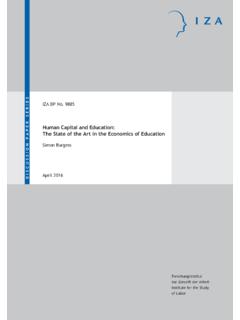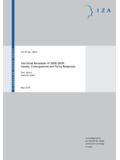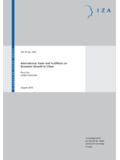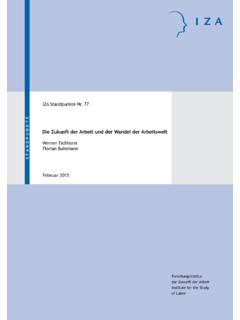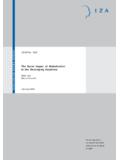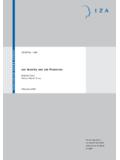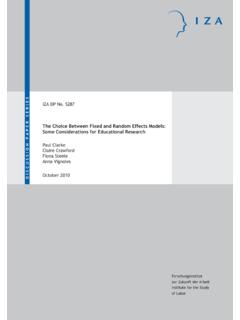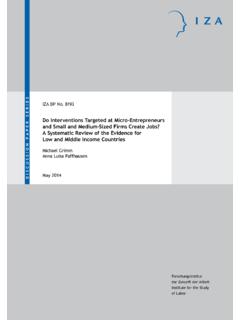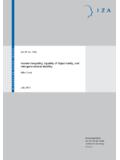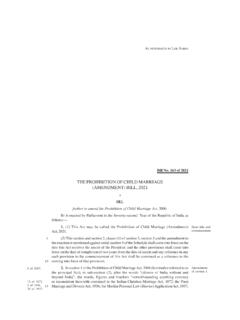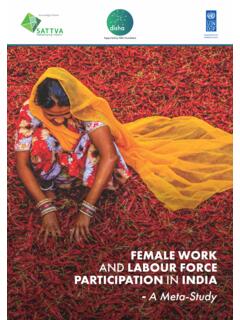Transcription of Female Labour Force Participation and Child Education in ...
1 D I S C U S S I O N P A P E R S E R I E SForschungsinstitut zur Zukunft der ArbeitInstitute for the Study of Labor Female Labour Force Participation and ChildEducation in India: The Effect of the NationalRural Employment Guarantee SchemeIZA DP No. 6593 May 2012 Farzana AfridiAbhiroop MukhopadhyaySoham Sahoo Female Labour Force Participation and Child Education in India: The Effect of the National Rural Employment Guarantee Scheme Farzana Afridi Indian Statistical Institute and IZA Abhiroop Mukhopadhyay Indian Statistical Institute and IZA Soham Sahoo Indian Statistical Institute Discussion Paper No. 65 93 May 2012 IZA Box 7240 53072 Bonn Germany Phone: +49-228-3894-0 Fax: +49-228-3894-180 E-mail: Any opinions expressed here are those of the author(s) and not those of IZA. Research published in this series may include views on policy, but the institute itself takes no institutional policy positions.
2 The Institute for the Study of Labor (IZA) in Bonn is a local and virtual international research center and a place of communication between science, politics and business. IZA is an independent nonprofit organization supported by Deutsche Post Foundation. The center is associated with the University of Bonn and offers a stimulating research environment through its international network, workshops and conferences, data service, project support, research visits and doctoral program. IZA engages in (i) original and internationally competitive research in all fields of labor economics, (ii) development of policy concepts, and (iii) dissemination of research results and concepts to the interested public. IZA Discussion Papers often represent preliminary work and are circulated to encourage discussion. Citation of such a paper should account for its provisional character.
3 A revised version may be available directly from the author. IZA Discussion Paper No. 6593 May 2012 ABSTRACT Female Labour Force Participation and Child Education in India: The Effect of the National Rural Employment Guarantee Scheme*E-mail: We study the impact of India s National Rural Employment Guarantee Scheme (NREGS) on children s educational outcomes via women s Labour Force Participation . Using data from the Young Lives Study and taking advantage of the spatial and temporal variation in the intensity of implementation of the NREGS, we find that greater Participation of mothers in the program is associated with better educational outcomes of their children. Father s Participation in the NREGS, on the other hand, has a negative effect on children s Education . Further, the estimated impact of mother s program Participation is over and above any income effect induced by the scheme and is robust to concerns about endogeneity of Labour Force Participation and differences in economic trends between districts.
4 We provide evidence which suggests that the mechanism through which children s educational outcomes improve is empowerment of mothers resulting from better Labour market opportunities for females. JEL Classification: I21, I38, J16 Keywords: Labour , Education , gender, bargaining Corresponding author: Farzana Afridi Indian Statistical Institute Planning Unit 7, Sansanwal Marg New Delhi 110016 India * We are grateful to Young Lives, which commissioned this study. The paper is under review for Young Lives Working Paper series. The data are from Young Lives, an international study of childhood poverty, following the lives of 12,000 children in 4 countries (Ethiopia, India, Peru and Vietnam) over 15 years ( ). Young Lives is core-funded from 2001 to 2017 by UK aid from the Department for International Development (DFID), and co-funded by the Netherlands Ministry of Foreign Affairs from 2010 to 2014.
5 Sub-studies are funded by the Bernard van Leer Foundation and the Oak Foundation. The views expressed here are those of the authors and are not necessarily those of, or endorsed by, Young Lives, the University of Oxford, DFID or other funders. 2 1. Introduction The World Development Report (2012), focusing on gender equality, finds that women in the poorer regions of the world continue to suffer from disadvantages in the economic sphere. Although, significant progress has been made in reducing gender disparities in health and educational outcomes, economic opportunities continue to be limited for women. The Report underlines the policy priorities of closing gender differences in access to economic opportunities and earnings as well as increasing women s voices within households as a means to reducing poverty in developing countries. In this paper we study the impact of one such policy initiative in India the National Rural Employment Guarantee Scheme (NREGS) initiated in 2006.
6 While the program s main objective is to alleviate rural poverty by legally guaranteeing a minimum of 100 days of annual employment to households, it also has the potential to empower rural women through greater access to Labour market opportunities. From a gender perspective, there are two interesting features of this program. First, the wage rate provided in this program is uniform across gender, and second, it gives priority to Female employment and targets at least one third of the beneficiaries to be women. Thus, NREGS not only has the potential to raise Female Labour Force Participation rates by bringing employment opportunities almost to their doorsteps, the equal wage rates provided in NREGS program can potentially reduce any gender disparity prevalent in the rural Labour markets. We, therefore, hypothesize that the introduction of this program should lead to greater Labour Force Participation of women, either on the extensive or intensive margin or both.
7 3 A rise in women s Labour Force Participation can potentially impact individual and household behaviour on several fronts including marriage, fertility, and intra-household distribution of resources. This paper analyzes the effect of the exogenous policy shock of the implementation of the NREGS on children s well being. Specifically, we explore whether an increase in Participation of mothers in NREGS projects affects the educational outcomes of their children differently from that of fathers Participation in the program. If yes, we attempt to understand the mechanism through which this differential effect can be explained. While an increase in either fathers or mothers Labour supply could improve their children s outcomes purely due to an income effect, greater Labour Force Participation of mothers could impact children s Education through two additional channels. First, women (including mothers) are likely to have more alternative uses of their time than men market work, household chores and leisure.
8 If children s time in doing household chores substitutes for mother s time then an increase in NREGS Participation of mothers may lead to a decline in educational attainment of her Second, mother s say in household resource allocation decisions may rise due to her higher earned income. Research suggests that this is likely to have a positive effect on her children s schooling. If an increase in women s earned income is likely to translate into greater weight being attached to their preferences in resource allocation decisions of the household and mothers prefer to invest more in their children s health and Education (Blumberg 1988; Thomas 1990; Hoddinott and Haddad 1995; Quisumbing and Maluccio 2003), relative to 1 If mother s and children s time on household chores are not substitutes and Child care services in the market are either unavailable or unaffordable, then it is more likely that children are in school when mothers are at work.
9 If children attend school more regulary due to mothers working, then children s educational outcomes might improve. 4 fathers, then we should see an improvement in Child outcomes. Therefore, an increase in mother s decision-making ability within the family can have a positive impact on her children s welfare (Thomas 1990; Thomas et al. 2002). To sum, the net impact of a change in mother s Participation in the Labour Force on her children s schooling depends on which of these two effects dominates the substitution effect or the effect of greater bargaining power, holding household income There exists relatively little empirical research on the impact of parental Labour supply on children s time allocation, particularly in a developing country context. Skoufias (1993) shows that an increase in Female wages in rural India reduces the time in school significantly for girls only. Similar results were found by Grootaert and Patrinos (1999) in a cross-country study.
10 However, Ilahi (1999) does not find any impact of Female wages on children s time use in Peru. In contrast to the sparse literature on time allocation effects, there is considerable empirical evidence suggesting that households resource allocation decisions are made in a collective (Chiappori, 1988) or bargaining framework (McElroy and Horney, 1981) where the final allocation usually depends on the bargaining power or weights attached to the preferences of the members of the household. The importance of Labour income as a determinant of women s bargaining power within the household has been highlighted recently by Anderson and Eswaran (2010). Using data from Bangladesh, the authors show that the effect of earned income on Female autonomy is far greater than that of unearned income. Also, women who work on the household farm have no more autonomy than those who are housewives, while those who earn independent income 2 We are abstracting from any long term effects of changes in fertility due to increased Labour Force Participation of women since we are looking at these changes over 2 to 3 years only.
